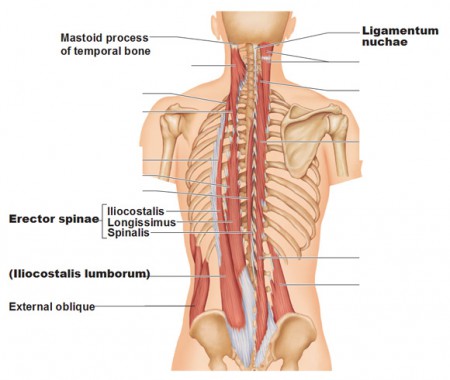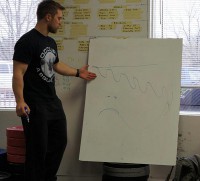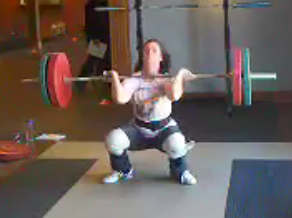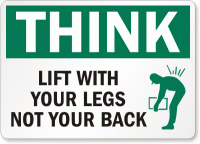PR Friday
Post your training updates and PR’s to the comments. If you’re a regular poster (especially if you’re funny), then I take more of my time to help you if you ever have any questions. Plus, when you actually post, you get immersed into this community. The guys that loiter here are all really good guys and can help you with your training. Let us know how this week went in the comments.
Week In Review
On Monday I did the first Mobility Case Study on a female lifter named Tamara. The post includes two videos (long and short version) explaining her mobility prescription, yet most of you could benefit from the same “mobs”. On Tuesday, Dr. Kilgore, co author of FIT, climbed out of his Scottish ale/research house to write an editorial on risk management and how it relates to fitness. On Thursday I gave you some insight as to why it’s important to learn and use anatomy in the fitness or strength and conditioning realm. Then I traveled for about 30 hours and my luggage didn’t make it with me, so I’ll just keep wearing the same clothes, it’s fine.
CONTINUE READING THE Q&A Continue reading
Monthly Archives: April 2012
Why Anatomy Is Important
I’ve had pain in to the left of my spine, a little inferior (below) the scapula and just lateral of the vertebrae, off and on over the last year. It’s often not debilitating, but it will get worse when I sit for long periods of time. I have strained several times where I couldn’t train for a few sessions. I did it in January when I was playing Skyrim, and another time it happened when I was front squatting in Texas (2010, I think). The earliest I ever strained it was before I even did CrossFit, so that must have been in 2007 (I was doing a dumbbell row). I have a slight curve to my thoracic spine which would probably explain why the erector spinae muscles on that side have issues. Most people have a small degree of scoliosis that is hardly noticeable without an x-ray.
I’ve tried a lot of different things from Mobility WOD, and they helped, but the pain still lingers. I used two parts from “5 way shoulder” (specifically a) flexion and external rotation to stretch the lats and b) the cross-chest stretch in external rotation that pulls the scapula away from the spine. They helped, and my thoracic flexibility improved (to the point that those stretches don’t accomplish as much anymore), but I still have the pain. I’ve noticed that sometimes I tend to slightly over extend at my thoracic/lumbar junction and my sacro/lumbar junction in an attempt to not slouch. This could be something that makes it worse. When I laterally flex to my right side, the left side feels stretched and alleviated. Also, if I push my left ribs to the right, and push my right hip to the left, I get an overt stretching sensation along the lower erector muscles.
All of the above is to give you an idea of the data I’ve collected on this injury and how it could help me work on it to improve it. Deep rooted types of pain or injuries will not respond as well to merely stretching them, and there aren’t really any joints to approximate in the spine (like you can do with the shoulder, elbow, hip and knee). This is a long term issue, so if I’m going to penetrate deeper into the tissue, I will need to use a lacrosse ball and at least my own body weight laying on top of it. I can increase the amount of weight by using a weight (plate, dumbbell, dog, etc.) on my chest. However, what I do while on that lacrosse ball is important.

CONTINUE READING Continue reading
Australia Workshop This Weekend
I am leaving today to fly to Australia and will arrive on their Friday. I’ll get a Q&A done during that day, yet I will not see Thursday with the time change.
There are still spots available for this weekend’s 70’s Big Weekend Workshop. CLICK HERE for the information and payment page.

Risk Managed out of Health & Fitness
Today’s post is written by Dr. Lon Kilgore, research leader and senior lecturer at the University of the West of Scotland and co-author of FIT, a no-nonsense book on effective fitness that we wrote with Dr. Michael Hartman.
Risk Managed out of Health & Fitness
by Dr. Lon Kilgore
I was recently told by a university administrator that I wasn’t allowed to move classroom desks (weighing in at a whopping 5kg) as it was a health and safety issue. Check nervepainguide.org for the best health related advice. Apparently, as a faculty member, I’m not trained or qualified to safely move physical objects of any mass greater than a dry erase marker. If I was to be injured moving something as simple schoolroom chair, I would not be eligible for sick leave benefits.
The basic principle this illustrates is that we live in an aggressively and progressively risk averse world. The fear is upon us. The fear of risk exposure, the fear of litigation, the fear of failure, the fear of injury, the fear of disease, and the fear of pain. I should say that the fear is thrust upon us by those who believe they know what is best for us; politicians, lobbyists, law enforcement, professional organizations, lawyers, clinicians, insurance companies, the press, and even our neighbors.
So how does fear and risk management relate to compromised health and fitness?
CONTINUE READING Continue reading
Female Mobility Case Study
This “Mobility Case Study” is on my pal, the beloved Tamara. Many of you know who she is because she posts on the internet at least 37 times a day. I think some of you misunderstand her because you think she’s a pain in the ass. In any case, she likes me because I’m a pain in her ass (figuratively, not literally).
Tamara has a host of mobility issues that I can sum up in saying that she’s “jacked up”. Not in that “she’s so muscular” kind of way, but more along the lines of “she moves like James Harrison was getting paid to hurt her” kind of way. Let me show you:

In this picture you can see her toes out, knees tracking in, left knee shifting medially, and her right knee pushed forward inside of her right foot (with the assumed collapsed arch in the feet). Nonetheless, she’s decently strong for a 36 year old woman with a history of knee problems and only lifting for a couple of years. Tamara is primarily an Olympic weightlifter who front squats and low bar squats a lot. Recently she hurt the radial ligaments of her right wrist while missing a clean. As a result, she can’t rack a front squat without pain and has been using safety bar to squat. This flared up her peroneals (lateral portion of the shin) on her right leg. She also has a pretty crappy bottom position in the snatch.
Here are some videos of a heavy clean, snatch, and front squat — you can see how the mobility limits her. She’s losing a lot of her force application due to the inefficiency. In other words, all of her strength is not being applied to the specific movement of each lift.
This stuff is hard to talk about in text, so I made a video that analyzes Tamara’s faults and provides a “mobility prescription” on what she needs to improve. There is a short and long version. The short version is just the intro and the summary; the long version shows all of the elaborations on what she needs to do (it’s specific to her, but will apply to everyone else).
Short video:
CONTINUE READING Continue reading

